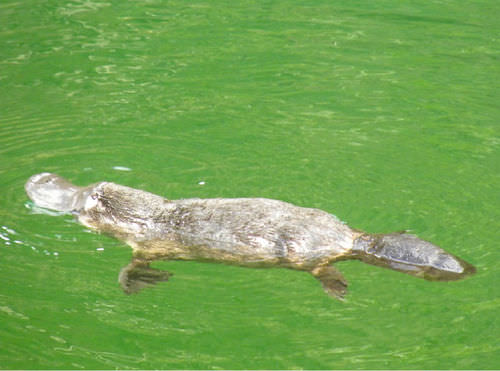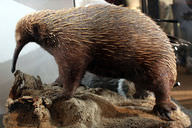16.44 单体 - 高级
章节大纲
-
Can a mammal lay an egg ?
::哺乳动物能产卵吗?This is a mammal. But it is unlike placental or mammals. If a mammal does not develop within a placenta or a pouch, what type of is left? Eggs!
::这是哺乳动物,但不同于胎盘或哺乳动物。如果哺乳动物没有在胎盘或邮袋中发育,那么剩下什么类型?蛋!Monotremes
::单色Only five living of mammals are not viviparous . They are called monotremes. Monotreme mammals lay eggs instead of giving birth to live young. They are the only living order in the mammalian subclass called Prototheria, which also includes several extinct orders. Living monotremes include one species of platypus and four species of echidna (see Figure ). Modern monotremes are found only in Australia and New Guinea.
::哺乳动物只有5个活体是非活性动物,它们被称为单体动物。单体哺乳动物产卵,而不是生儿育女。它们是哺乳动物亚类中唯一一个叫Prototheria的存活顺序,它也包含几个灭绝的顺序。活体单体动物包括一种白化虫和四种埃希德纳(见图 ) 。 现代单体动物只在澳大利亚和新几内亚出现。Platypus. Long-beaked echidna. Short-beaked echidna. Like female therian mammals , female monotremes have ovaries that produce eggs. Unlike therian mammals, monotremes lack a uterus and vagina . The word monotreme literally means “one hole.” The name refers to the single body opening, or cloaca , that monotremes use for urination , defecation, and . The presence of a cloaca is a trait that monotremes share with both lizards and .
::与雌性哺乳动物一样,雌性单体动物也有产卵卵的卵巢。与雌性哺乳动物不同,单体动物缺乏子宫和阴道。单体动物一词的字面意思是“一个洞 ” 。 名称指的是单体开口,或者说Cloaca, 单体开口用于尿液、排便和。 Cloaca的存在是单体与蜥蜴和蜥蜴共有的特性。Eggs and Lactation
::鸡蛋和哺乳Eggs produced by monotreme mammals leave the mother’s body through the cloaca. Monotreme eggs are similar to the eggs of . For example, they have a leathery outer covering, like reptile eggs, rather than a hard, calcified shell like the eggs of birds. However, unlike reptiles, female monotremes retain their eggs for some time (typically for two or three weeks) and actively provide the eggs with nutrients . Female platypuses lay their eggs in burrows. Echidna females have a pouch in which they store their eggs and later nurse their young.
::单体哺乳动物产出的蛋通过木薯离开母体。单体蛋与蛋类似。例如,它们有皮质外罩,如爬虫蛋,而不是像鸟卵那样硬的、刻板的贝壳。然而,与爬虫类不同,雌性单体将卵保留一段时间(通常为两三个星期 ) , 并积极为卵提供营养。 雌性白质蛋在洞穴产卵。 雌性雌性雌性有袋储存卵,后来喂幼小。Like other mammals, female monotremes have mammary glands that produce milk. However, female monotremes do not have nipples. Instead, they feed their young by “sweating” milk from a patch on their belly.
::与其他哺乳动物一样,雌性单体动物有乳房哺乳性腺,但雌性单体动物没有乳头,相反,它们用腹部的“湿”牛奶喂养幼虫。Pros and Cons of Monotreme Reproduction
::单体生殖的利弊The mother’s investment in reproduction is obviously less in monotremes than in therian mammals. The female monotreme does not carry an embryo in a uterus while it develops. On the other hand, externally laid eggs are more difficult to protect than an embryo in a uterus or a pouch on the mother’s belly. Therefore, monotreme offspring may be less likely to survive than the offspring of therian mammals.
::母亲对生殖的投资显然比对单体哺乳动物的投资要少。 母单体雌性单体在子宫发育期间不会携带胚胎。 另一方面,外蛋比子宫胚胎或母体腹部的邮袋更难保护。 因此,单体后代可能比雄性哺乳动物的后代更难生存。Other Monotreme Traits
::其他单体轨迹Monotremes have other traits that set them apart from both placental and marsupial mammals. For example, adult monotremes lack teeth, whereas other mammals normally retain their teeth throughout . The monotreme shoulder girdle is also different from those of other mammals, having an extra called the interclavicle. In addition, monotremes have sprawling limbs extending along their sides rather than lying underneath the body as in other mammals. This arrangement of limbs makes monotremes walk like lizards. Although monotremes have hair and are endothermic, their body temperature is 5 o to 10 o C lower and their metabolic rate is more variable than those of marsupial or .
::单体与胎盘和哺乳动物有区别的其他特性。 比如, 成年单体动物缺乏牙齿, 而其他哺乳动物通常会在整个体内保留牙齿。 单体肩臂环状与其他哺乳动物也不同, 外号为间圈。 此外, 单体动物的侧侧侧有伸展的四肢, 而不是像其他哺乳动物一样躺在身体下方。 这种肢体的排列使单体动物像蜥蜴一样行走。 虽然单体动物有毛发和内温, 它们的身体温度比其他哺乳动物低5°到10°C, 其代谢率比其他哺乳动物或哺乳动物的多变。Summary
::摘要-
Monotreme mammals lay eggs instead of giving birth to live young.
::单体哺乳动物产卵,而不是生儿育女。 -
Unlike therian mammals, monotremes lack a uterus and vagina.
::与自然哺乳动物不同,单体动物缺乏子宫和阴道。 -
Similar to birds and reptiles, monotremes have a single body opening (the cloaca).
::与鸟类和爬行动物相似,单体有一个单一的体开口(cloaca)。 -
Monotreme eggs are similar to the eggs of reptiles.
::单体卵与爬行动物卵相似。 -
Adult monotremes have many physical features that distinguish them from other mammals.
::成人单一体有许多物理特征,与其他哺乳动物有区别。
Review
::回顾-
What distinguishes animals in the subclass Prototheria? Where are these animals found?
::动物在亚类蛋白质类动物中有何区别?这些动物在哪里被发现? -
How is the reproductive system of monotremes similar to that of birds and some reptiles?
::单体动物的生殖系统如何与鸟类和一些爬行动物的生殖系统相似? -
How do the monotreme eggs compare with other animal eggs?
::单体卵与其他动物卵相比如何? -
What are some differences between reptile parental care and monotreme parental care?
::爬行动物父母照料与单一父母照料之间有什么区别? -
How do monotremes feed their young?
::单体动物如何喂养他们的青春? -
What are some physical features that distinguish monotremes from other mammals?
::将单体与其他哺乳动物区别开来的一些物理特征是什么?
-
Monotreme mammals lay eggs instead of giving birth to live young.



